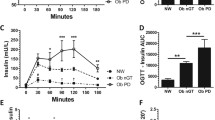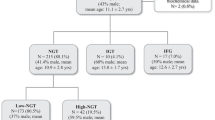Abstract
The natural history of impaired glucose tolerance (IGT) and Type 2 diabetes among obese children is not clear. Although the cut-off for impaired fasting glucose (IFG) has recently been changed from 110 (6.1 mmol/l) to 100 mg/dl (5.6 mmol/l), it does not seem a reliable way to find all subjects with impaired glucose homeostasis. The aim of our study was to determine whether high-normal fasting glucose level could predict the occurrence of IGT and metabolic syndrome. Three hundred and twenty-three Italian obese children and adolescents were included in the study (176 females, mean age 11±2.9 yr; mean body mass index z-score: 3±0.6). Waist circumference, serum glucose, insulin, triglyceride, cholesterol HDL, blood pressure were evaluated and an oral glucose tolerance test (OGTT) was performed. The prevalence of IFG and IGT were respectively 1.5% (5 subjects) and 5% (18 patients); no diabetic patients were found. Metabolic syndrome was diagnosed in 20% of patients. Fasting glycemia values <100 mg/dl (5.6 mmol/l) have been divided in quintiles. Metabolic syndrome prevalence increased across quintiles, although not in a statistically significantly manner, but it could depend on the selected diagnostic criteria as no univocal definition exists for metabolic syndrome in youths. Interestingly high-normal fasting plasma glucose levels constitute an independent risk factor for IGT among obese children and adolescents; therefore, this very easy-to-use parameter may help to identify obese patients at increased risk of diabetes or at least could suggest in which subjects to perform an OGTT.
Similar content being viewed by others
References
Sokol RJ. The chronic disease of childhood obesity: the sleeping giant has awakened. J Pediatr 2000, 136: 711–3.
Molnár D. The prevalence of the metabolic syndrome and type 2 diabetes mellitus in children and adolescents. Int J Obes Relat Metab Disord 2004, 28 (Suppl 3): S70–4.
Sinha R, Fisch G, Teague B, et al. Prevalence of impaired glucose tolerance among children and adolescents with marked obesity. N Engl J Med 2002, 346: 802–10.
Wiegand S, Maikowski U, Blankenstein O, Biebermann H, Tarnow P, Grüters A. Type 2 diabetes and impaired glucose tolerance in European children and adolescents with obesity — a problem that is no longer restricted to minority groups. Eur J Endocrinol 2004, 151: 199–206.
Invitti C, Guzzaloni G, Gilardini L, Morabito F, Viberti G. Prevalence and concomitants of glucose intolerance in European obese children and adolescents. Diabetes Care 2003, 26: 118–24.
Pinhas-Hamiel O, Zeitler P. The global spread of type 2 diabetes mellitus in children and adolescents. J Pediatr 2005, 146: 693–700.
Kaufman FR. Screening for abnormalities of carbohydrate metabolism in teens. J Pediatr 2005, 146: 721–3.
American Diabetes Association. Type 2 diabetes in children and adolescents. American Diabetes Association. Diabetes Care 2000, 23: 381–9.
Grandone A, Amato A, del Giudice EM, Perrone L. Low prevalence of impaired fasting glucose in obese adolescents from Southern Europe. Pediatrics 2006, 118: 2603.
Gilardini L, Girola A, Morabito F, Invitti C. Fasting glucose is not useful in identifying obese white children with impaired glucose tolerance. J Pediatr 2006, 149: 282.
Cacciari E, Milani S, Balsamo A, et al. Italian cross-sectional growth charts for height, weight and BMI (2 to 20 yr). J Endocrinol Invest 2006, 29: 581–93.
Cole TJ. The LMS method for constructing normalized growth standards. Eur J Clin Nutr 1990, 44: 45–60.
Zannolli R, Morgese G. Waist percentiles: a simple test for atherogenic disease? Acta Paediatr 1996, 85: 1368–9.
National High Blood Pressure Education Program Working Group on High Blood Pressure in Children and Adolescents. The fourth report on the diagnosis, evaluation, and treatment of high blood pressure in children and adolescents. Pediatrics 2004, 114 (Suppl): 555–76.
Tanner JM, Whitehouse RH. Clinical longitudinal standards for height, weight, height velocity, weight velocity, and stages of puberty. Arch Dis Child 1976, 51: 170–9.
Weiss R, Dziura J, Burgert TS, et al. Obesity and the metabolic syndrome in children and adolescents. N Engl J Med 2004, 350: 2362–74.
Cook S, Weitzman M, Auinger P, Nguyen M, Dietz W. Prevalence of a metabolic syndrome phenotype in adolescents: findings from the third National Health and Nutrition Examination Survey, 1988–1994. Arch Pediatr Adolesc Med 2003, 157: 821–7.
Matthews DR, Hosker JP, Rudenski AS, Naylor BA, Treacher DF, Turner RC. Homeostasis model assessment: insulin resistance and beta-cell function from fasting plasma glucose and insulin concentration in man. Diabetologia 1985, 28: 412–9.
Amemiya S, Dobashi K, Urakami T, Sugihara S, Ohzeki T, Tajima N. Metabolic syndrome in youths. Pediatr Diabetes 2007, 8 (Suppl 9): 48–54.
Calcaterra V, Klersy C, Muratori T, et al. Prevalence of metabolic syndrome (MS) in children and adolescents with varying degrees of obesity. Clin Endocrinol (Oxf) 2008, 68: 868–72.
Lee S, Bacha F, Gungor N, Arslanian S. Comparison of different definitions of pediatric metabolic syndrome: relation to abdominal adiposity, insulin resistance, adiponectin, and inflammatory biomarkers. J Pediatr 2008, 152: 177–84.
Invitti C, Gilardini L, Viberti G. Impaired glucose tolerance in obese children and adolescents. N Engl J Med 2002, 347: 290–2.
Gabir MM, Hanson RL, Dabelea D, et al. The 1997 American Diabetes Association and 1999 World Health Organization criteria for hyperglycemia in the diagnosis and prediction of diabetes. Diabetes Care 2000, 23: 1108–12.
Shaw JE, Zimmet PZ, Hodge AM, et al. Impaired fasting glucose: how low should it go? Diabetes Care 2000, 23: 34–9.
Kim DJ, Kim KW, Cho NH, Noh JH, Lee MS, Lee MK. The cutoff value of fasting plasma glucose to differentiate frequencies of cardiovascular risk factors in a Korean population. Diabetes Care 2003, 26: 3354–6.
Thomas GN, Chook P, Qiao M, et al. Deleterious impact of “high normal” glucose levels and other metabolic syndrome components on arterial endothelial function and intima-media thickness in apparently healthy Chinese subjects: the CATHAY study. Arterioscler Thromb Vasc Biol 2004, 24: 739–43.
Tirosh A, Shai I, Tekes-Manova D, et al. Israeli Diabetes Research Group. Normal fasting plasma glucose levels and type 2 diabetes in young men. N Engl J Med 2005, 353: 1454–62.
Author information
Authors and Affiliations
Corresponding author
Rights and permissions
About this article
Cite this article
Grandone, A., Amato, A., Luongo, C. et al. High-normal fasting glucose levels are associated with increased prevalence of impaired glucose tolerance in obese children. J Endocrinol Invest 31, 1098–1102 (2008). https://doi.org/10.1007/BF03345659
Accepted:
Published:
Issue Date:
DOI: https://doi.org/10.1007/BF03345659




